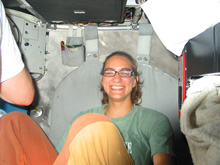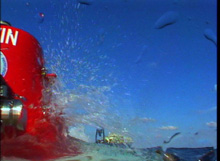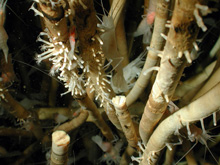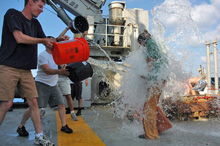
Texas A&M-Corpus Christi student Adriana Leiva is all smiles during her dive in the deep submergence vehicle (DSV) Alvin. Click image for larger view and image credit.
This frame grab was taken from the DSV Alvin video camera just prior to submergence. The research vessel (R/V) Atlantis is visible in the background. Click image for larger view and image credit.
Finding a Dream in the Deep Sea
May 19, 2006
Adriana Leiva
Undergraduate
Student
Texas A&M University-Corpus Christi
27 38.84 N
088 22.41 W
![]() Sea cucumbers are a common component of deep-sea fauna. (Quicktime, 1.3 Mb.)
Sea cucumbers are a common component of deep-sea fauna. (Quicktime, 1.3 Mb.)
Never had I imagined that I would be descending to the sea floor inside the deep submergence vehicle (DVS) Alvin. This is one of those childhood dreams that one has while watching all those great ocean videos. Today I realize that anything and everything is possible as long as those dreams are still alive. I did not expect to have this kind of opportunity when I started working for Dr. Ian MacDonald at Texas A&M University in Corpus Christi, sorting through thousands of pictures from the deep sea. That may not sound particularly exciting to many people, but the more I looked, the more I appreciated how wonderful the deep sea really is. I never thought it would lead to being out here in the middle of the Gulf of Mexico on the research vessel (R/V) Atlantis and inside the DSV Alvin.
For today’s dive, the pilot is Bruce Strickrott, the port observer is Dr. Chuck Fisher, chief scientist for the expedition, and the starboard observer is me — an undergraduate student with a great experience ahead of me.
As we descend from the loud warm surface waters into the dark silence of the big blue I feel the temperature in the sphere begin to drop. Once we are completely immersed in darkness, Bruce flashes all the lights for a second. Traces of bioluminescent creatures begin to glow outside our viewports. They look like neon green figures dancing in a black void. A few meters before arriving to the bottom, all lights come on to stay and I finally get to see the world of all the photographs.
We land right next to a clump of creatures extending from the mud in long, slender housings. These are the tubeworms I have seen so many pictures of. In person, I notice that their smooth tubes have many tiny creatures growing on them. Little shrimp swim around them. Some tubes have anemones hanging like lanterns. The mud around the worms is covered with patches of bacteria, making patterns of white and brown and blue.
Transiting along the bottom, I see a maze of mud trails with round balls at the end. “Sea urchins,” I point out excitedly and Bruce slows the submarine and strategically begins to collect mud samples from this active site. Chuck points out a hermit crab in a borrowed shell, carrying an anemone on his back. The anemone made the crab almost look like he had a punk hair style. It made me smile to think about life taking advantage of opportunities — above the surface and below!
Our third target is an area discovered during Erik and Jill’s dive. They named it "The Mussel Brick Road," because the massive path of mussels seemed to go on and on. Though the mussels are impressive, I’m somewhat skeptical that we’ve found their target. What we’ve found looks more like a potholed access road and not the massive interstate of mussels that they described. Visibility deep down under is very limited; even if the things you are looking for are a few meters away, you might miss them completely.
Though at times frustrating, the limited visibility also provides another level of excitement and wonder. You never know what is just up ahead. Even though I have a long way to go with my studies, coming on this cruise has made me think of the different paths my life and studies could take. What started as a student job has become an amazing part of my life. Who knows where I’ll end up next?
Sign up for the Ocean Explorer E-mail Update List.































